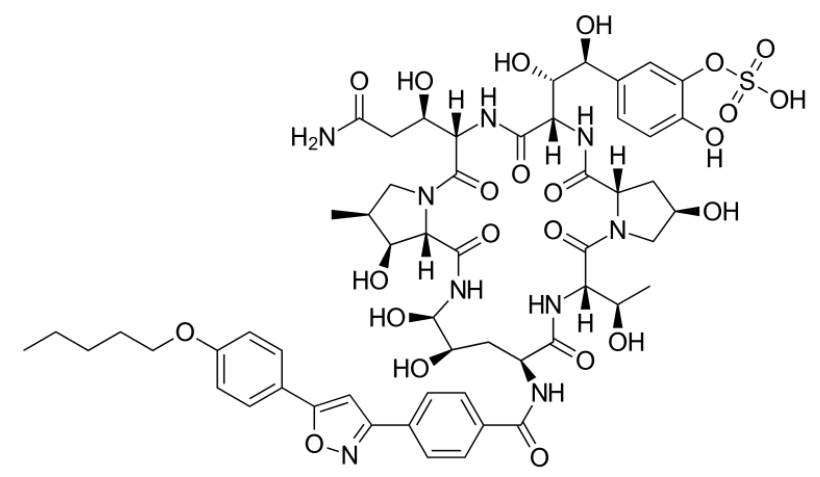Playlist
Show Playlist
Hide Playlist
Flucytosine (5-Fluorocytosine/5-FC) – Antifungals
-
Slides Flucytosine Antifungals.pdf
-
Reference List Pharmacology.pdf
-
Download Lecture Overview
00:01 Flucytosine is a water-soluble pyrimidine analog related to the chemotherapeutic agent 5-fluorouracil (5-FU). 00:10 It disrupts both DNA and RNA synthesis. 00:13 It has a narrow spectrum of action but is usually combined with amphotericin B to treat severe cryptococcal pneumonia and meningoencephalitis The mechanism of action involves flucytosine being taken up by fungal cells via the enzyme cytosine permease, as noted in step 1. 00:31 In step 2, it is converted to 5-fluorouracil (5-FU) by cytosine deaminase, which is not present in mammalian cells, which is an example of selective toxicity. 00:43 In Step 3, 5-FU is further metabolized into 5-fluorodeoxyuridine monophosphate (5-FdUMP), which inhibits thymidylate synthase, an enzyme crucial for the synthesis of thymidine monophosphate (dTMP), a necessary precursor for DNA synthesis. 01:02 This inhibition disrupts DNA synthesis, preventing cell replication. 01:06 5-FU is also converted into 5-fluorouridine monophosphate (5-FUMP), as seen in step 4. 01:14 In step 5, 5-FUMP is phosphorylated to form 5- fluorouridine triphosphate (5-FUTP). 01:22 5-FUTP is incorporated into RNA in place of uridine, leading to the production of faulty RNA, which disrupts protein synthesis and interferes with essential cellular processes. 01:33 So both DNA and RNA synthesis are interrupted; this is unlike other antifungal agents, which target the cell membrane, like amphotericin B and azoles or the cell wall, like the echinocandins. Synergy with both amphotericin B and azole drugs has been demonstrated. 01:51 Flucytosine is most commonly used in combination with amphotericin B for the treatment of severe cryptococcal pneumonia and meningoencephalitis. 02:01 This combination is highly effective in managing these serious fungal infections, particularly in immunocompromised patients, such as those with HIV/AIDS. 02:10 While less frequently used, 5-FC can also be part of a combination regimen for certain invasive candidal infections. 02:17 It’s especially considered when the infections are particularly severe or resistant to other treatments. 02:23 Flucytosine is used in selected cases of chromoblastomycosis, a chronic fungal infection caused by dematiaceous molds. 02:31 In these cases, the drug may be combined with other antifungals to enhance efficacy. 02:35 Monotherapy with flucytosine is generally avoided due to the high incidence of resistance. 02:41 However, it may be used in specific situations, such as treating fluconazole-resistant candidal urinary tract infections. This is one of the few scenarios where 5-FC might be used alone, but even then, it’s often reserved for less severe infections where alternative treatments are not viable. 02:59 Understanding the pharmacokinetics of 5-FC is essential particularly when treating patients with compromised renal function. 03:06 Flucytosine is primarily eliminated by glomerular filtration, with a half-life of 3 to 4 hours in patients with normal renal function. 03:14 Importantly, 5-FC is removed by hemodialysis, which has implications for dosing in patients undergoing dialysis. 03:23 In patients with renal impairment, 5-FC levels can rise rapidly, leading to potential toxicity. This is particularly a concern in AIDS patients and those with renal insufficiency. 03:34 In these populations, close monitoring of drug levels is essential, and dose reductions are often necessary to avoid adverse effects. 03:42 The standard dosage of 5-FC in patients with normal renal function is 100 mg per kilogram per day, divided into multiple doses. 03:51 It's crucial to adjust this dosage in patients with impaired renal function to prevent toxicity. 03:57 In North America, 5-FC is available only in oral formulations, which may limit its use in certain clinical scenarios where intravenous administration would be preferred. 04:08 Flucytosine’s adverse effects primarily arise from its metabolism into the toxic compound 5-fluorouracil (5-FU), which can occur possibly through the action of intestinal flora. This metabolic pathway is concerning because 5-FU is a well-known antineoplastic agent, and its toxicity can be significant, particularly in vulnerable populations. 04:32 The most common adverse effect of flucytosine is bone marrow toxicity, eading to cytopenias such as anemia, leukopenia, and thrombocytopenia. 04:43 This toxicity is particularly problematic in AIDS patients and those with renal insufficiency, as they are more susceptible to the accumulation of toxic metabolites. 04:53 Although less common, flucytosine can also cause hepatic necrosis, which is typically reflected in elevated liver enzymes. 05:00 This requires careful monitoring of liver function during treatment. 05:04 Another potential, though less frequent, adverse effect is toxic enterocolitis, which can lead to significant gastrointestinal distress. 05:13 Given the narrow therapeutic window of flucytosine, regular monitoring of drug levels and patient health is essential to avoid toxicity while ensuring the drug remains effective. 05:24 It is important to measure peak serum concentrations of flucytosine periodically. This helps in adjusting the dose to maintain therapeutic levels while minimizing the risk of toxicity. 05:35 Due to the risk of bone marrow suppression, a complete blood count should be monitored every other day. 05:41 This frequent monitoring helps in early detection of cytopenias, allowing for timely intervention if toxicity develops. 05:48 Resistance to flucytosine is a significant clinical challenge and can arise through mutations in several key enzymes within the fungal cell, including cytosine permease: which is responsible for transporting flucytosine into the fungal cell. 06:04 Mutations that impair its function can prevent the drug from entering the cell, rendering it ineffective. 06:10 Once inside the cell, flucytosine is converted to 5-FU by cytosine deaminase. 06:16 Mutations in this enzyme can block this conversion, stopping the drug from becoming active and thus leading to resistance. 06:23 Uracil phosphoribosyl transferase converts 5-FU into 5-fluorouridine monophosphate, a crucial step in the drug’s mechanism of action.
About the Lecture
The lecture Flucytosine (5-Fluorocytosine/5-FC) – Antifungals by Pravin Shukle, MD is from the course Antimicrobial Pharmacology.
Included Quiz Questions
What toxicity is associated with flucytosine administration?
- Bone marrow suppression
- Cirrhosis
- Visual impairment
- Hallucinations
- Organomegaly
Which drug may be combined with flucytosine to create a synergistic antifungal effect?
- Amphotericin B
- Griseofulvin
- Ampicillin
- Vancomycin
- Nystatin
Customer reviews
5,0 of 5 stars
| 5 Stars |
|
5 |
| 4 Stars |
|
0 |
| 3 Stars |
|
0 |
| 2 Stars |
|
0 |
| 1 Star |
|
0 |




